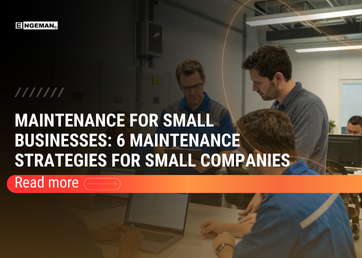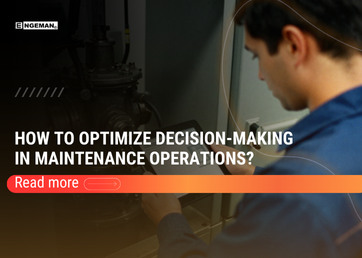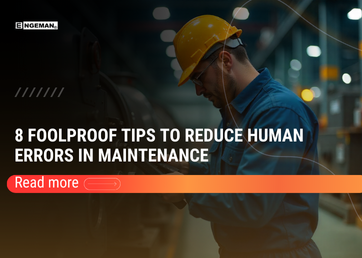Contents
What is Preventive Maintenance meaning?
Preventive maintenance embraces the set of planned and systemic inspections which are performed periodically, regardless of equipment operation conditions. The purpose is preventing failures in equipment operation through potential failures anticipation. In this way, sudden downtime can be avoided, contributing to avoid losses and reduce maintenance costs.
We can say that preventive maintenance stays more in the management field. With this, it is possible to reduce the number of interventions, to increase availability time, predict any possible failure, to increase reliability, to ensure security among others.
Every company, regardless of its size, needs to keep all its equipment in perfect operation. It is inevitable that with use and time, there is a part wear or the need for lubrication and changes. With a planned follow-up it is possible to make interventions at appropriate time.
Every asset, which is defined such as all and any items that a company can control, should be controlled, and well inspected from acquisition to disposal. Keeping preventive maintenance avoids the disposal of assets before time and thus avoiding unexpected losses.
Another important view in preventive planning actions is to be controlled by professionals that really have experience. Knowing all processes as well as the company routine in which they are working is a crucial factor because they will know maintenance history and operation of each equipment.
Preventive maintenance examples
Preventive maintenance should be done in the aimed way, following all orientations of equipment manufacturers. Keeping this practice will help to preserve parts lifespan. Some Preventive Maintenance examples:
- Regular lubrication;
- Ultrasonography;
- Calibration;
- Electric Current measurement;
- Instruments measurement;
- Cleaning;
- Thermographic;
- Continuous inspections;
- Systematic reviews;
- Vibrations analysis, among others.
Preventive maintenance can also happen according to the condition of certain equipment when there is a need to repair some defect or general servicing. Thus, it is possible to establish more precise deadlines to equipment replacement.
What are Preventive Maintenance benefits and advantages?
Preventive maintenance is an important practice that brings several benefits, both for the company itself and for its employees. Here are some advantages you will have when investing in this strategy in your maintenance management:
- Prevent corrective maintenance once actions are taken before equipment downtime or damage;
- Reduce equipment wear once during the servicing it is possible to have a sense of which parts can break;
- Increases productivity;
- It is an investment because it avoids costs that can be discovered during the preventive;
- Time optimization once it is already strategies informed that will be used in the interventions;
- Increases parts lifespan;
- Increases efficiency;
- Avoid accidents, among other things.
The time to perform preventive maintenance is shorter than the one to corrective maintenance, for example. This is because, in this case, the equipment is in perfect operation.
How to perform the Preventive Maintenance?
So that preventive maintenance occurs in proper way and, it is essential to make a schedule with all equipment and its components data, in addition to deadline expected to perform interventions. It is an important ally in equipment conservation and durability, once it is possible to keep operation conditions next to manufacturer conditions. To perform preventive maintenance, some steps can be followed such as:
- Mapping all information: with this it is possible to analyze equipment history, what are the most common failures, map the equipment, and which are crucial to the manufacturing process and for this reason cannot stop. Define a period and collect all data so that, from there, you can draw the best strategies for your segment.
- Set deadlines: considering that preventives are all scheduled, you prevent important assets in your maintenance process from being downtime. By doing this, it is even possible to map the actions and establish frequency that each maintenance should happen.
- Prepare your team: everyone should know the equipment that they work on to identify any failure that leads to emergency maintenance.
- Create a checklist: after all data collected, create the checklist of how maintenance process of each equipment will be. This ensures that every step is always followed to the letter and no step is ignored. This will bring more safety to your process.
- Define a schedule to be followed: with all information properly recorded, set the frequency that should happen in each maintenance, which employees will work in this maintenance.
Keeping preventive maintenance well-structured and in operation can ensure that company is always prepared and even that it achieves quality certifications, because its processes are well organized.
What is the importance of Preventive Maintenance?
Regardless of the program used by the company, maintenance management aim is to make equipment as available as possible. After all, failures from an unexpected downtime can be huge.
When an equipment stops suddenly, several parts are damaged. In addition, with production interruption, it will not be possible to meet customer demands, this brings huge financial losses and affects organization image.
Before taking action, a maintenance schedule will help you to organize all information and enhance and optimize all your processes and maintain your productivity and profitability. Therefore, a good equipment maintenance program contributes to reducing costs in maintenance department.
Conclusion
A downtime represents costs with parts replacement and, also, production interruption. Companies that aim to always remain competitive on the market need to always seek the best results and for this to happen, optimization of their processes must be continuous.
Preventive maintenance is focused on planning the activities. Using it strategically enhances results in its production.
With technology use, industry 4.0 and industry 5.0, decisions have become much more assertive, changing the level of those companies that know how to resolve technology with maintenance procedures. Thus, companies can remain more competitive and in full growth, even in times of crisis.
Follow our social networks to always be well informed about the maintenance universe!




